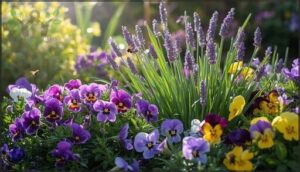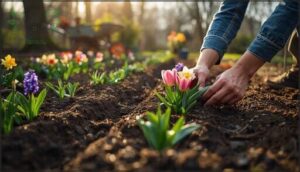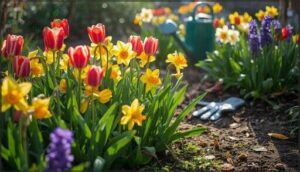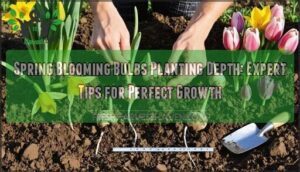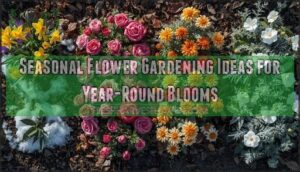This site is supported by our readers. We may earn a commission, at no cost to you, if you purchase through links.
Every spring, garden beds wake up in a riot of color, but not by accident. A garden bursting with flowers is crafted from choices as deliberate as picking the right moment to sow a seed or mixing compost into the earth until it’s rich with promise.
Climate and timing become as important as the palette of petals, and even a humble daffodil asks for just the right spot and soil.
If growing flowers in spring has ever felt like a puzzle missing a few pieces, the next steps promise a practical path from that first shovel of dirt to armfuls of blooms.
Table Of Contents
Key Takeaways
- Matching your flower choices to your climate, soil, and sun is crucial for a thriving spring garden.
- Preparing rich, well-drained soil and planning garden layouts in advance sets your blooms up for success.
- Staggering planting times and mixing perennial and annual varieties keeps color going all spring.
- Regular watering, deadheading, and pest-friendly practices will help your flowers stay healthy and blooming longer.
Choosing The Best Spring Flowers
There’s a world of color waiting for you in spring, but not every flower fits every garden. Choosing what to plant starts with knowing your space—sun, soil, and climate make all the difference.
Let’s look at what matters most when picking your perfect spring blooms.
Popular Spring-Blooming Varieties
A tapestry of color truly defines spring—think tulips dazzling in every hue, daffodils sturdy under brisk winds, and pansies greeting cool mornings.
Explore spring blooms by petal variations and bloom periods: hyacinths’ rich fragrance, snapdragons’ playful shapes, and begonias’ singular hardiness.
Popular spring flower varieties thrive with thoughtful tulip care and by mixing daffodil types for show-stopping displays. These flowers, including daffodils and tulips, are hardy in several zones, making them an adaptable choice for many gardens.
Perennial Vs. Annual Spring Flowers
Tulips and daffodils bring a feast for the eyes, but have you weighed the lifespan comparison and cost analysis between perennial and annual spring flowers? Perennial flowers return year after year with regular care, offering lasting value, while annuals like marigolds provide vibrant seasonal adaptation and quick color.
Choosing between them depends on whether you prefer flowers that thrive for a single season. Think about your maintenance needs and planting spring flowers that fit your rhythm.
Flower Selection by Hardiness Zone
If you want spring flowers that thrive from year to year, look beyond a plant’s pretty face—think Zone boundaries, heat tolerance, and microclimate quirks. Plant selection and identification hinge on accurate zone maps, but local shifts or new hybrid cultivars can nudge that comfort zone wider.
Provenance influences what survives cool snaps or brutal sun. Annuals adapt; perennials enjoy stability.
Edible and Fragrant Flower Options
Once you factor in your garden’s climate zone, it’s time to explore edible and fragrant flower options. Spring Flower Characteristics that delight your palate or nose add new layers:
- Violas—delicate Edible Petals and subtle taste
- Lavender—classic Fragrant Blooms for Culinary Flowers
- Scented herbs like chive blossoms—double-duty in Floral Nutrition
- Pansies—cheerful, edible spring flowers
Mix these for both Spring Flower Fragrance and flavor.
Preparing Your Garden for Spring Blooms
As the days grow longer and the soil thaws, it’s time to set your garden up for a burst of spring color. Preparing your space is all about giving your flowers the best shot at thriving.
Here’s what you’ll want to think through before you plant.
Soil Preparation and Amendments
Think of your soil as the bedrock for every spring bloom—it deserves some TLC. Start with a soil test to uncover pH balance or nutrient deficiencies.
Work in organic matter for improved structure, aiming for rich, crumbly earth. Amendment timing matters: incorporate compost or aged manure well before planting.
These gardening tips set the stage for vigorous, colorful growth.
Sunlight and Drainage Requirements
Light intensity is your spring gardening secret weapon; most spring flowers thrive on six hours of morning sun, boosting bloom rates and reducing disease.
For lasting success, drainage solutions are a must—over 90% of spring blooms falter in soggy ground.
Consider temperature impact, photoperiod effects, and smart container considerations so roots stay healthy and blossoms stay plentiful.
Garden Bed and Container Planning
A well-planned spring garden starts with smart Bed Layout and Container Size. Aim for 30-inch-wide raised beds with pathways for easy access, and leave at least 12 inches for Soil Depth. Prioritize Drainage Systems—think gravel or raised containers—for healthy blooms.
When Garden Planning and Design, cluster colors and layer heights to create striking Garden Aesthetics that last through the season.
Layering for Succession Blooming
Ever notice how one patch of color fades just as another pops? That’s not luck—it’s succession blooming done right. Master Spring Garden Planning by weaving these tactics into your routine:
- Bridge bloom gaps with staggered sowing
- Stack bulb flowers in vertical garden layers
- Boost pollinator diversity with mixed species
- Improve land yield through careful Spring Flower Planting
Planting Spring Flowers Successfully
Planting spring flowers is all about timing, technique, and visual flair. With a few expert tips, your garden can burst into color just when you want it.
Here’s how to set up your flowers for a vibrant spring show.
When to Plant Bulbs and Seeds
Curious when to put those bulbs and seeds in the ground? For spring flowers, timing is everything: follow your region’s planting window, chill bulbs as needed, and pay attention to soil temperature—40–50°F is ideal for hardy bulbs.
Even if you’re overdue, you can still plant, but expect changes in flowering. Adjust your seed sowing interval for the variety—every detail matters.
Proper Planting Depth and Spacing
Ever wondered why some spring flowers just don’t thrive? Getting Soil Depth and Flower Spacing right is like setting the stage for a perfect performance—roots need elbow room and proper light.
Use these Planting Techniques for your Spring Flower Planting Guide:
- Plant bulbs 3x their height deep
- Space annuals and perennials according to plant size
- Measure distances for even Garden Layout
Grouping Flowers for Visual Impact
When you think about Garden Design, creating visual energy in your spring flower beds comes down to smart Group Arrangement and Color Combination. Layer heights—tall at the back, sturdy perennials in the middle, drifts of low annuals in front.
Mix warm and cool colors, vary bloom sequencing, and pair bold leaves with airy foliage to keep your Flower Arrangements vibrant all season.
Supporting Tall or Delicate Plants
As you work on grouping those flowers for visual pop, don’t skip the basics of Plant Staking and Stem Support. Tall or top-heavy blooms need a little backup. For sturdy results, focus on:
- Flower Bracing in storms
- Trellis Systems for climbers
- Grow Through grids early on
- Regular checks during Garden Maintenance and Care
- Flexible weaving as plants stretch skyward
Caring for Spring Flowers Throughout The Season
Good care can make all the difference once your spring flowers start to bloom. Here’s what to keep in mind as you work to keep your garden healthy and full of color.
Let’s walk through the basics you’ll want to follow all season long.
Watering and Fertilization Tips
With spring warming up, pay close attention to watering frequency and soil moisture—deep, early-morning watering helps roots grow strong. Match fertilizer types and timing with your plants’ needs: bulbs love a boost just as shoots emerge. Good water quality means longer-lasting blooms, and staying on top of spring garden maintenance keeps your flower care routine thriving.
| Gardening Tips | Details |
|---|---|
| Water Frequency | Once or twice weekly; increase as temperatures rise |
| Soil Moisture | Keep consistently damp (not soggy) for root health |
| Fertilizer Timing | Apply as shoots appear, never to dry soil |
| Water Quality | Use low-pH, clean water for best plant care |
Deadheading and Pruning Practices
Once you’ve settled into a watering groove, shift focus to flower care with targeted deadheading and timely pruning. Cutting back faded blooms and snipping branches just after their show means more energy for next year’s display.
Regular garden maintenance like this boosts bloom longevity, aids disease prevention, and keeps your flower beds looking tidy and healthy—classic spring flower care in action.
Dividing and Replanting Perennials
Perennial Division is Garden Renewal in action—it’s about more than just splitting roots. This important Gardening Technique keeps mature plants vigorous, encourages Root Care, and sparks Plant Rejuvenation.
Perennial Plants thrive when you dig and divide after blooming, carefully replanting healthy clumps in well-prepped, humus-rich soil. Every slice and soil tuck puts new life and color into your spring beds.
Managing Pests and Attracting Pollinators
As you tend your flower beds, blending IPM practices like monitoring techniques with biocontrol methods—such as predatory insects—can keep pests in check. Companion planting marigolds or cosmos naturally draws in helpful pollinators, improving Flower Care and Maintenance.
Thoughtful garden design that nurtures Pollinator habitats ensures your blooms thrive, weaving Nature and Wildlife into your Gardening Tips and Advice.
Designing and Maintaining a Vibrant Spring Garden
Designing a spring garden is as much about planning as it’s about day-to-day care. The best displays come from thoughtful choices and a little creative effort.
Here are some key ways to help your spring flowers shine all season.
Creating Colorful Flower Arrangements
Ever notice how a bold Spring Bouquet can brighten a whole room? This season’s Flower Color Trends highlight pastel hues, sculptural Arrangement Styles, and creative use of Floral Textures that give Flower Arrangements character. To build standout arrangements, focus on:
- Monochromatic Seasonal Themes
- Varying bloom shapes
- Layering heights
- Mixing fresh and foraged foliage
Using Raised Beds and Containers
Curious how to get stunning color in tight spaces? Raised Bed Design and Container Gardening make Spring Flower Gardening accessible—especially for beginners.
With good Soil Optimization, you can double your blooms and slash weeding chores. Whether stacking pots for Vertical Planting or filling a tidy bed, smart Space Saving and careful Soil Preparation and Planting give flowers exactly what they crave.
Attracting Bees and Butterflies
Wondering how to turn your spring flower garden into a hotspot for winged visitors? Start with pollinator-friendly choices—think open-faced blooms and nectar sources rich in pollen diversity.
Strategic garden design and planting clusters transform ordinary beds into thriving butterfly gardens. Mix annuals and perennials, and your space will buzz with bee attraction all season, bringing color and wildlife in tandem.
Seasonal Garden Maintenance Strategies
Spring gardening is a bit like a dance—move with the rhythm of the season instead of fighting it. Embrace Climate Adaptation by updating your routines; Soil Testing fine-tunes every bloom. Focus on Water Conservation and Garden Renewal in your maintenance schedule:
Spring gardening thrives when you adapt with the weather, test your soil, and renew with careful water conservation
- Early pest control strengthens young blooms
- Mulch layers conserve moisture and energy
- Smart irrigation reduces water waste
Small steps, brighter gardens.
Frequently Asked Questions (FAQs)
How can I extend the blooming period of spring flowers?
Like threading pearls on a string, you can extend your flower season by Succession Planting, regular Deadheading Flowers, matching flower varieties to local Temperature, keeping up Soil Fertility, and using thoughtful Calendar Planning for non-stop, blooming flowers.
What are the best companion plants for spring blooms?
Mixing marigolds, sweet alyssum, and nasturtiums among your spring flowers boosts pollinator attraction, deters pests, enriches soil health, and ensures color succession. Thoughtful placement maximizes spatial efficiency for your bulbs, perennials, and annual blooms.
Are there common diseases that affect spring flowers?
Think of your flower beds as neighborhoods—just as trouble sometimes moves in, so do plant diseases. Fungal infections, bacterial diseases, and viral prevalence can test your plant care skills, affecting bloom quality and even your garden’s economic impact.
Can spring flowers tolerate unexpected late frosts?
Most spring flowers show some frost tolerance, especially hardy varieties like calendula and snapdragon, but late frosts can cause delayed flowering and damage.
Use protection methods—like covers—or plant bulbs deeply to help with recovery and resilience.
How do I store bulbs after spring flowering?
Once spring flowers fade, don’t rush foliage management; let leaves yellow fully first.
After lifting bulbs, cure in a dry, ventilated spot, use peat moss or vermiculite for storage, and check regularly for any signs of disease.
Conclusion
Even if your thumbs aren’t green yet, picture the delight of walking through a garden you’ve grown from seed to spring spectacle—each bloom a direct result of your choices. With the right steps, growing flowers in spring becomes less about guesswork and more about savoring small victories: petals opening, bees returning, colors weaving together.
Trust your intuition, try new varieties, and let your curiosity shape each bed. Your blooming garden reflects your care, effort, and genuine connection to nature.
- https://fieldreport.caes.uga.edu/publications/B1065/care-of-ornamental-plants-in-the-landscape/
- https://ornamentalhorticulture.com.br/rbho/article/download/809/570/2958
- https://globalplantcouncil.org/grasslands-study-finds-increasing-fertilizer-use-drastically-reduces-the-number-of-flowers-and-insects/
- https://www.holganix.com/turf-and-ornamental-data
- https://pmc.ncbi.nlm.nih.gov/articles/PMC6852653/





